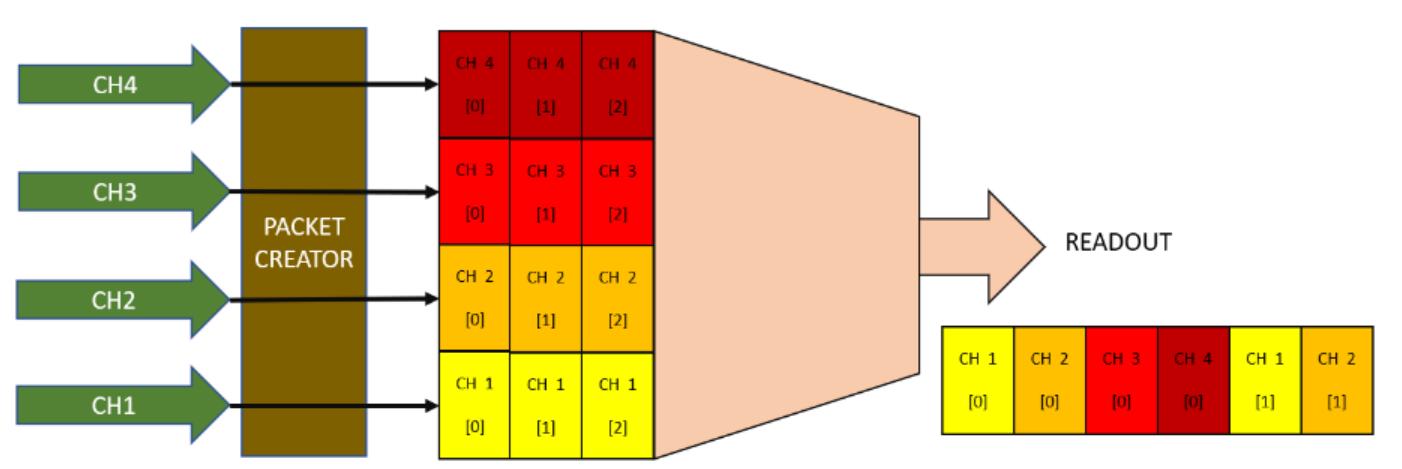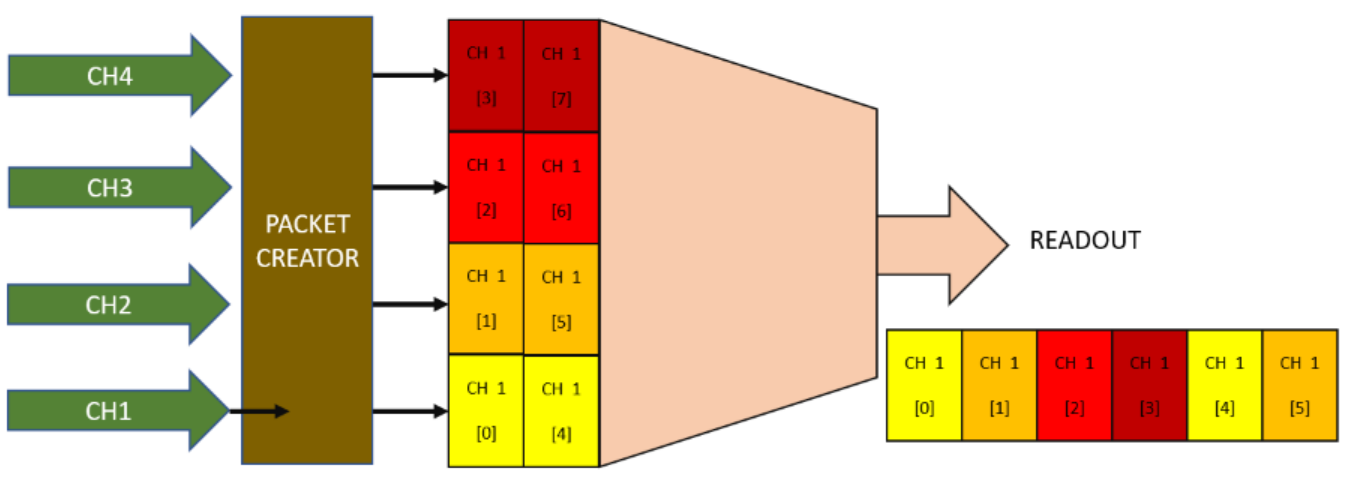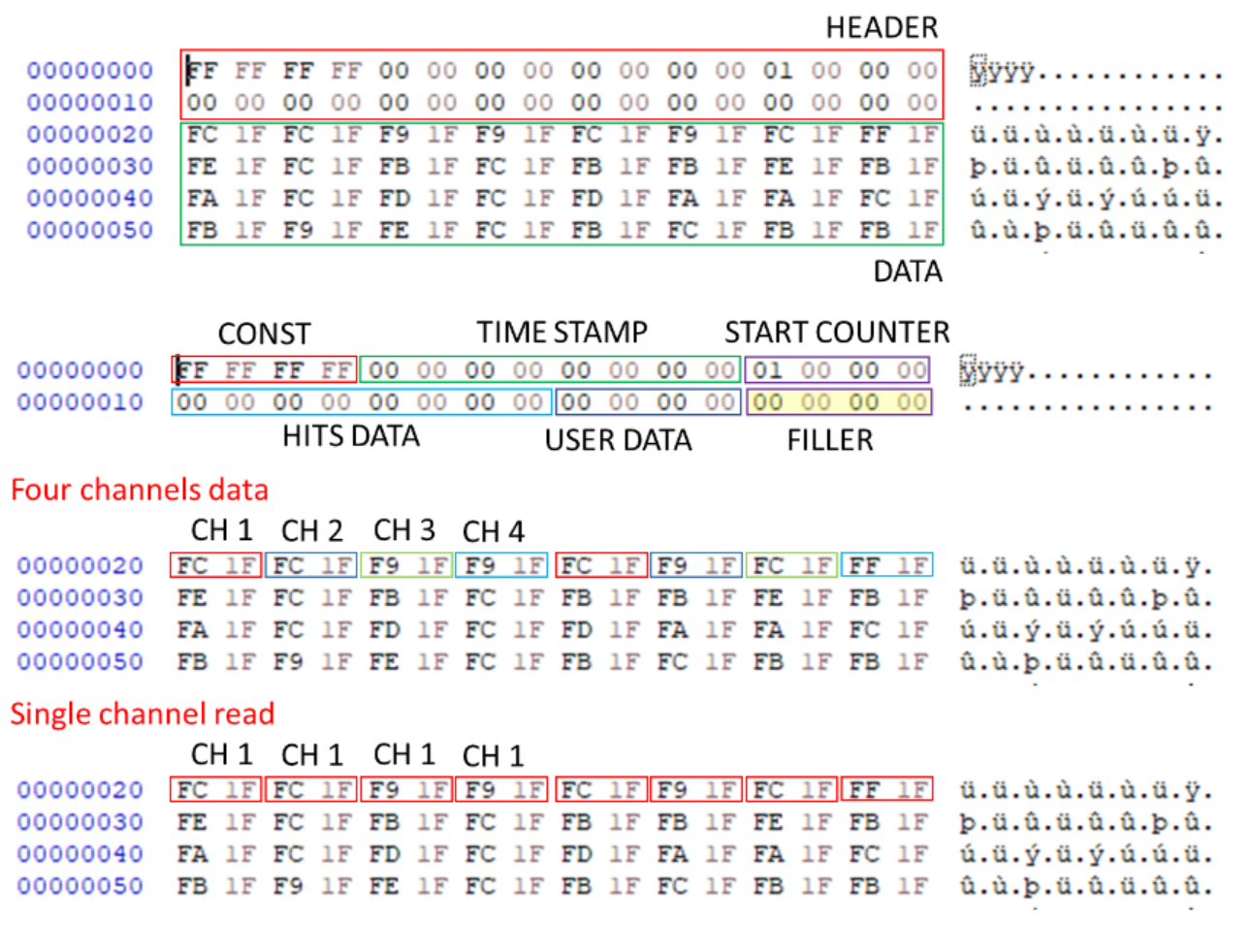|
SciSDK Library
SDK for Sci-Compiler projects
|
|
SciSDK Library
SDK for Sci-Compiler projects
|
The Wave Digitizer componet has the function to acquire multiple channels capturing waveform from each one. It is similar to the oscilloscope, but, while the oscilloscope purpose is to monitor the internal process of the firmware, and indeed is not very fast in transfering data, digitizer function is optimized to maximize the speed and the memory usage of the device. In the Wave Digitizer exist a shared memory for all channels for which the Wave Digitizer has been created. At compile time, Sci-Compiler defines the total size of this memory and the maximum number of channels. At runtime the user can configure if to enable one, two, four channels. The memory will be partitioned in function of the enable channels.
It is designed as following: a packet creator block serializes the enabled channels in a common FIFO and transfer data to the PC.
Every time a start signal is triggered, the timestamp, the hits and user data are captured, and enqueued in the output FIFO.
It is only possible the specify the number of channels (N) starting from the channel 0. So If N = 2, CH0 and CH1 will be dumped, if N = 4, CH0, CH1, CH2, CH3 will be dumped.
Example with four channels:


It is not possible to configre a pre-trigger on the Wave Digitizer. The trigger is always on the first sample. To implement a pre-trigger, it necessary to connect, on each input channel, a delay block with the desired delay (Sci-Compiler provide fixed and programmable delay block).
The readout can be configure to work in two different mode:
SCISDK_ReadData function will block until the buffer is full or the timeout is reached.SCISDK_ReadData function will return immediately with the number of bytes read.Raw Mode In raw mode the digitizer do not process packet and provide to the user application the raw data. The user application must be able to process the data and extract the information. Raw mode can be useful in order to save at the maximum speed the data to disk. The user application can be a simple script that save the data in a file. A second application can be used to process the data and extract the waveforms.
The following parameters can be configured:
| Parameter | Acces Mode | Description | Default value |
|---|---|---|---|
| acq_len | R/W | maximum number of sample to be transferred per physical FIFO access | 1024 |
| acq_mode | R/W | select blocking/non-blocking mode | blocking |
| timeout | R/W | set the timout in ms in blocking mode | 100 |
| high_performance | R/W | if true the internal FIFO access lock the bus in priority mode. | false |
| data_processing | R/W | set data processing mode: raw, decode | decode |
| enabledch | R/W | number of enabled channels. | –all ch– |
| buffer_type | R | get buffer type: SCISDK_OSCILLOSCOPE_RAW_BUFFER or SCISDK_OSCILLOSCOPE_DECODED_BUFFER | |
| channel_count | R | get buffer the number of channel created with Sci-Compiler | |
| fifo_size | R | get buffer the total number of samples in the output fifo created with Sci-Compiler | |
| max_ch_samples | R | return the maximum number of samples per channel can be read |
The acq_len parameter set the number of sample per channels to be read. The maximum value depends by tge number of channels enabled. The maximum value is the total size of the shared memory divided by the number of channels enabled. The driver suggest the maximum value for this parameter reading the max_ch_samples parameter.
In blocking mode the SCISDK_ReadData function will block until the buffer is full or the timeout is reached. In non-blocking mode the SCISDK_ReadData function will return immediately with the number of bytes read. The maximum number of bytes that can be read is the size of the buffer allocated with the function SCISDK_AllocateBuffer. In blocking mode the timeout is set with the timeout parameter. The timeout is expressed in ms. In non-blocking mode the timeout is not used. In both mode, if the buffer is fill with even just a single word the function will return NI_OK. If there is no data at all the read function will return NI_NO_DATA_AVAILABLE.
The enabledch parameter is the number of enabled channels. It is only possible the specify the number of channels (N) starting from the channel 0. So If N = 2, CH0 and CH1 will be dumped, if N = 4, CH0, CH1, CH2, CH3 will be dumped. Valid number are from 1 to the maximum number of channels created in Sci-Compiler.
The data_processing parameter can be used to set the data processing mode. The data processing mode can be set to raw or decode. In raw mode the data are not processed and the user will receive the raw data from the FPGA. In decode mode the data are processed and the user will receive the data as they are pushed in the FPGA fifo, loosing the concept of packet. The custom packet behavior is the same of the list In decode mode the data are analized, divided in packet and it is possible to check the alignment to an aligment word.
The following commands are available:
| Command | Description | Parameter |
|---|---|---|
| start | Clear the FIFO and start the acqusition | |
| stop | Stop the acquisition |
Start will clear the digitizer wave. All digitizer parameter can not be changed while the acquisition is in progress. Stop the digitizer before change any parameter or the property set will be rejected.
Raw mode In raw mode the buffer must be allocated with the function SCISDK_AllocateBuffer. In raw mode it is mandatory to specify the size of the buffer is FIFO word. The size of the FIFO word is 4 bytes (DWORD).
Decoded data The buffer is allocated using the SCISDK_AllocateBuffer function. The buffer is freed using the SCISDK_FreeBuffer function. There is no argument to be pass to the SCISDK_AllocateBuffer function. The allocator will allocate the buffer with the size for each channe large enough to contain the maximum number of samples per channel in the configuration with a single channel enabled (the worst case).
Raw mode In raw mode the data are not processed and the user will receive the raw data from the FPGA. This mode is useful to implement a simple script that dump the data on file and user will post process data with a second application.
The file dumped from the script above will save the file as a list of events.

The packet structure is the following: | WORD 0 | WORD 1 | WORD 2 | WORD 3 | WORD 4 | WORD 5 | WORD 6 | WORD 7 | | ----— | ----— | ----— | ----— | ----— | ----— | ----— | ----— | | HEADER || | CH0_0 | CH1_0 | CH2_0 | CH3_0 | CH0_1 | CH1_1 | CH2_1 | CH3_1 | | CH0_2 | CH1_2 | CH2_2 | CH3_2 | CH0_3 | CH1_3 | CH2_3 | CH3_3 |
The header is composed by the following fields:
In order to optimize the access speed to the memory, the size of the header must be alligned to the size of the data packet; this is met by adding a padding (filler) to the header. This table indicate the size of the filler
| Number of channels | FIFO word size (DW) | Filler size |
|---|---|---|
| 1 | 1 | 0 |
| 2 | 1 | 0 |
| 4 | 2 | 1 |
| 8 | 4 | 1 |
| 16 | 8 | 1 |
| 32 | 16 | 9 |
| 64 | 32 | 25 |
The channels are ordered as follow: every WORD (16 bit / 2 bytes) there is a channel. All channels are ordered from the first to the last. In the list there is just the data of the enabled channels. After a group of channels another sample for all the channels is stored. So the order is the following:
The data are stored in the following structure:
The magic field is a constant value that can be used to check if the buffer is valid. The data field is a pointer to the buffer. The data contains data in the format above The info field contains the information about the buffer:
buffer_size: the size of the buffer in DWORD (4 bytes)samples: the number of samples per channel when all the channels are enabledvalid_samples: the number of valid samples in the bufferchannels: the number of channels for which the digitizer has been createdDecoded data
In decode mode the user will receive data already decoded. The user has not to care about the packet structure and the alignment. The driver will produce in output an array with the waveform for each channel. The data are stored in the following structure:
The magic field is a constant value that can be used to check if the buffer is valid. The analog field is a pointer to the buffer. The analog contains data in the format above:
| CH | CH 0 | CH 1 | CH 2 | CH 3 |
|---|---|---|---|---|
| Sample | 0 .... n-th | 0 .... n-th | 0 .... n-th | 0 .... n-th |
The hits field contains the information about the channels that have triggered. The LSB is the first channel. The timecode field contains the timestamp of the event. The counter field contains the index of the event. The user field contains the user defined dword data. The info field contains the information about the buffer:
samples: the maximum number of samples per channel when all the channels are enabled. If less channels are enabled the number of samples will be less channels are enabled this number should be scaled accordingling to the following formula: max_acq_len = samples * (total_channels/enabled_channels)valid_samples: the real number of valid samples in the buffer. This number can be up to samples * enabled_channels if just one channel is enabled.channels: the number of channels for which the digitizer has been created.enabled_channels: the number of channels enabled channel in the current acquisition.You can find the labview file for this example here